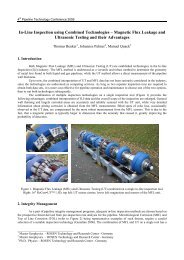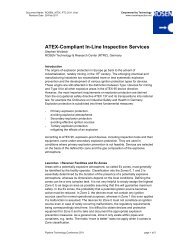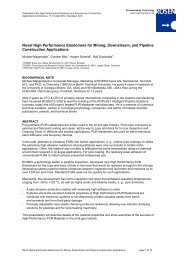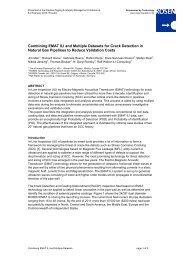View - ROSEN Inspection Technologies
View - ROSEN Inspection Technologies
View - ROSEN Inspection Technologies
You also want an ePaper? Increase the reach of your titles
YUMPU automatically turns print PDFs into web optimized ePapers that Google loves.
Proceedings of IPC 2006<br />
6 th International Pipeline Conference<br />
September 25-29, 2006, Calgary, Alberta, Canada<br />
IPC2006-10157<br />
IN-LINE INSPECTION OF DENTS AND CORROSION<br />
USING “HIGH QUALITY” MULTI-PURPOSE SMART-PIG INSPECTION DATA<br />
Steffen Paeper<br />
<strong>ROSEN</strong><br />
Technology and Research<br />
Center<br />
Am Seitenkanal 8<br />
49811 Lingen Germany<br />
spaeper@roseninspection.net<br />
ABSTRACT<br />
A new generation of geometry sensor for ILI tools has been<br />
developed. This sensor provides highly accurate geometry data<br />
of the internal pipe contour. The technology uses the benefits of<br />
a touchless distance measurement in combination with the<br />
advantages of a mechanical caliper arm. The complementary<br />
interaction allow the measurement of accurate data under<br />
demanding operational conditions.<br />
The geometry sensor technology can be combined with a<br />
navigation unit and the high resolution MFL inspection<br />
technology on so called multi-purpose ILI-tools. The merging<br />
of different inspection tasks on a single tool is an economic<br />
solution to create and add to an ILI-database for integrity<br />
management.<br />
Field experience with this new technology will be<br />
discussed, based on more than 500 miles inspected pipeline.<br />
Most inspections were performed in the US and Canada. The<br />
operational performance of the sensors justified the new design.<br />
INTRODUCTION<br />
The last five years have seen some important changes in<br />
the requirements for ensuring pipeline integrity and the<br />
associated utilization of in-line inspection (ILI) tools as a<br />
primary integrity assessment method. This is mainly reflected<br />
in the U.S. Code of Federal Regulations for Transportation of<br />
Gas and Liquids (parts 192 and 195, respectively) where more<br />
prescription has been given to actionable anomalies or threats<br />
to integrity. One in particular is that for the minimum geometry<br />
required for the detection, sizing and assessment of dents which<br />
could have an affect on the integrity of a pipeline.<br />
Knowingly, as recently as two years ago, the so-called<br />
“state-of-the-art” in geometry inspection has been redefined.<br />
This has changed both the operators’ viewpoint, as well as the<br />
Bryce Brown<br />
<strong>ROSEN</strong><br />
North America<br />
14120 Interdrive East<br />
77032 Houston, TX USA<br />
bbrown@roseninspection.net<br />
Thomas Beuker<br />
<strong>ROSEN</strong><br />
Technology and Research<br />
Center<br />
Am Seitenkanal 8<br />
49811 Lingen Germany<br />
tbeuker@roseninspection.net<br />
regulators, on ILI geometry surveys from one of asset operation<br />
and monitoring to utilizing them as a basis for a defect<br />
remediation process.<br />
A novel technology for the characterization and sizing of<br />
dents has been developed by <strong>ROSEN</strong>. This high-resolution ILI<br />
technology combines the advantage of a touchless electronic<br />
measuring system with the advantages of the well-established<br />
caliper-arm tools, allowing full compensation of the sensor<br />
bounce under highly dynamic operational loads.<br />
Taking this a step farther, combining this new geometry<br />
inspection technology with the already established highresolution<br />
magnetic flux leakage (MFL) or circumferential<br />
MFL (CMFL) technologies, offers an operator access to the<br />
majority of the repair conditions as outlined in the regulations<br />
in a single run, and still not compromising such valuable<br />
operational characteristics such as 1.5D bend negotiation.<br />
INTEGRITY MANAGEMENT OF PIPELINES<br />
Integrity management of pipelines in the U.S. is regulated<br />
by federal codes for both liquid and gas pipelines.<br />
Both rules contain prescriptive integrity management<br />
provisions for the pipeline operator. These prescriptions define<br />
limits for pipeline geometric anomalies like mechanical damage<br />
and dents. For example, the minimum requirement for the<br />
sizing of dents is prescribed: a high-resolution geometry tool<br />
must be able to detect and size dents with a depth greater or<br />
equal to 0.25” (6.35mm). Additionally, a process for inspecting<br />
against provisions of a management based rule, rather than<br />
inspecting for compliance with a purely prescriptive rule is<br />
encouraged [1].<br />
The discussion in recent literature about possible failure<br />
modes of mechanical damage in pipelines is strongly<br />
recommending: anything but a plain dent must be analyzed<br />
1 Copyright © 2006 by ASME
carefully and with relevant expertise. The latest investigations<br />
confirm the dependency of failure pressure on the dent shape<br />
rather than on the dent depth [2], [3]. This is also reflected in<br />
the regulations, recommending engineering analyses wherever<br />
needed, and ability to assess the strain associated with dents. A<br />
stress riser like corrosion, a gouge or a crack within a dent or<br />
between dents, rerounding of unconstrained dents or shape and<br />
sharpness of dents, need to be considered within the appropriate<br />
assessment method. While the failure assessment process is not<br />
prescribed in the new regulations, the (integrity) management<br />
measures and management consequences are (refer to figure 1).<br />
Figure 1: The Intergrity Management process typically goes<br />
beyond the evaluation of the purely prescriptive information<br />
.<br />
GEOMETRY ILI TOOLS – HIGH QUALITY APPROACH<br />
As mentioned previously, basic information for dents and<br />
ovalities, as we have known it, do not address the necessities<br />
for a proper defect assessment.<br />
The state-of-the-art in geometry inspection has changed<br />
over the last two years. This is in order to provide pipeline<br />
operators better tools to assist them in meeting the intent of the<br />
rulemaking when it comes to ILI as the integrity assessment<br />
method of choice.<br />
The “classic” geometry inspection for ovalities and large<br />
deformation does not provide the required information for a<br />
dent assessment as discussed above. This is also indicated in a<br />
more recent publication and study on the subject of geometric<br />
anomalies, where the probability of detection (POD) was only<br />
32%, based on field verification activities of 78 excavations [4].<br />
With the new regulations, this cannot be accepted.<br />
A “high-quality” ILI process for dents and mechanical<br />
damage can provide required information such as the geometry<br />
of dents and data on stress risers to start a managed integrity<br />
process for the inspected line (refer to Figure 1). The more<br />
high-resolution and “high-quality” information that is available<br />
about an anomaly found, the better the subsequent failure<br />
analysis can be.<br />
It is important not only to size and describe the dents with<br />
high accuracy, but also to detect and characterize the before<br />
mentioned stress risers. State-of-the-art for the characterization<br />
of the stress riser are high-resolution ILI tools based for<br />
example on the magnetic flux leakage principle. In combination<br />
with one of these tools, a “high-quality” geometry tool and a<br />
navigation unit can be combined on a multipurpose tool<br />
(Figure 2), so that the required data can be obtained during a<br />
single inspection run.<br />
CIRCUMFERENTIAL RESOLUTION AND COVERAGE<br />
The performance of a geometry inspection configuration<br />
for dents can be estimated by using straight forward analytical<br />
models. According to these models, the sizing accuracy and the<br />
probability of detection (POD) for dents can be determined as a<br />
function of the circumferential resolution and the coverage of<br />
the sensing area.<br />
Due to the linear equation connecting the pipeline diameter<br />
with its circumferential perimeter, the coverage of a single unit<br />
tool is linked to the ID-passage of the unit. A fully assembled<br />
single inspection plane would also complicate the negotiation<br />
of 1.5D bends. As a rule of thumb, the coverage for a single<br />
plane geometry tool equals the specified passage minus 15%.<br />
Thus, a typical caliper tool with a passage of 75% would cover<br />
only 60% of the physical internal pipe surface. This can lead to<br />
a significantly reduced POD and to an undersizing of the dent<br />
depth as the internal contour is not been sampled completely.<br />
(refer to Figure 3).<br />
Therefore, an accurate sizing of dents or other geometric<br />
anomalies in a pipeline requires 100% coverage over the<br />
circumference by the geometry sensors. To achieve this, the<br />
inspection solution must consist of two inspection planes,<br />
where the trailing sensor unit is covering the gap of the preceding<br />
unit. The tool design for the <strong>ROSEN</strong> high-resolution<br />
geometry inspection system (XGP) consists of two sensor units<br />
circumferentially offset to each other and hence guarantee100%<br />
physical coverage of the internal surface (refer to Figures 2).<br />
Figure 2: ILI multipurpose 24” tool. Combining MFL<br />
technology with high quality geometry inspection. Two<br />
measurment planes for the geometry sensor are required to<br />
provide full coverage under all operational conditions.<br />
2 Copyright © 2006 by ASME
Figure 3: Undersizing of dents as a function of coverage and<br />
number of caliper arms for a sharp dent with a tip angle<br />
a=120º. The maximum undersizing factor is a worst case<br />
scenario.<br />
MECHATRONIC SENSOR<br />
A disadvantage of the traditional mechanical caliper tool<br />
design, where the mechanical movement of the caliper is<br />
transformed into a position signal, is the dynamic behavior of<br />
the arms under run conditions. This typically leads to inspection<br />
speed restrictions. Above a critical tool speed, the caliper arm<br />
starts to lose continuous contact with the internal surface of the<br />
pipeline. But also at low speeds abrupt changes at the internal<br />
pipe surface may not be monitored correctly.<br />
Pure mechanical designs which try to overcome these<br />
problems have to be lightweight and hence are quite fragile.<br />
Therefore, these systems do not extend the operational range of<br />
this inspection task.<br />
Figure 4: Combination of conventional mechanical caliper<br />
concept(B) with a touchless operating proximity sensor (d).<br />
A solution for this problem is provided by a touchless<br />
measurement technology. To achieve high measurement<br />
accuracy and a satisfying circumferential resolution a<br />
mechanical caliper arm system equipped with a sensor to<br />
transform the mechanical movement into an electric signal and<br />
an electronic distance measurement were combined to a<br />
mechatronic solution.<br />
Figure 4 shows the touchless electronic sensor integrated<br />
inside the sensor head and a position sensor attached at the base<br />
of the sensor arm monitoring the mechanical position. The<br />
touchless electronic sensor is used to compensate data obtained<br />
from the dynamic behavior of the caliper arm. The unwanted<br />
effects of the caliper’s inertia is fully assimilated by the<br />
touchless measurement. Sharp transitions at the internal<br />
surface, such as a pipe misalignment at a girth weld, are<br />
monitored very well. Another example explains how the<br />
contour of a dent is monitored by the compensation method.<br />
Figure 5 shows the result simulated at 6.72mph (3 m/s).<br />
Figure 5: Compensated signal from a dent obtained with the by<br />
summation of the mechanical movement measurement and the<br />
touchless proximity signal.<br />
This example also emphasizes the tendency of oversizing<br />
the dent length by a pure mechanical caliper arm.<br />
Since the electronic sensor is insensitive to non-conductive<br />
material, the compensation method is always referring to the<br />
internal surface of the pipeline. Scale or wax debris, although<br />
detected by the system, will not affect the geometry evaluation<br />
of the pipeline.<br />
A single mechatronic unit is designed to cope with a toolspeed<br />
of up to 11.2 mph (5m/s) and to provide an accuracy of<br />
0.03” (0.8mm) for radial measurements.<br />
ANALYSIS FOR STATIC DENT STRAIN<br />
The accurate measurement of the dent geometry is the<br />
basis for a strain and subsequent stress analysis. For a static<br />
analysis of the stress in a dented area the bending strain at the<br />
material surface has to be known. With the strain stress curve<br />
the static stress at the dent surface can then be estimated. For an<br />
analysis of the strain in a dent area, the curvature of the dent<br />
surface has to be determined, because the strain at the surface is<br />
3 Copyright © 2006 by ASME
directly defined by the wall thickness and the curvature at the<br />
area of interest. Mathematically the curvature is defined by the<br />
second derivative of a parameterization of such geometry.<br />
Therefore the measurement data has to be parameterized or<br />
resampled to calculate the curvature in the dent region. It has<br />
already been shown that this procedure delivers good results<br />
when being compared to FEM calculations.[5]<br />
To perform the needed calculations with the measurement<br />
data, the data has to be parameterized or resampled to a suitable<br />
resolution. The first challenge is to transform the data, to an<br />
equidistant grid. Another issue is the required continuity of the<br />
second derivative of the resulting geometry information, since<br />
the second derivative is the basis for curvature calculation, like<br />
discussed above. 100% circumferential coverage of the<br />
measurement system makes this analysis more confident, since<br />
it can be assumed that the maximum depth of the dent geometry<br />
has been hit. Therefore no extrapolations (overshoots) have to<br />
be considered for the transformation.<br />
Therefore well established interpolation methods exist.<br />
Generally, cubic splines show continuity of the second<br />
derivative, but also show oscillations and overshoots. Cubic Bsplines<br />
are already used for such calculations [5]. But artificial<br />
contour-changes caused by un-wanted oscillations of splines<br />
produce non compliant strain results.<br />
For this reason, a combination of spline and Hermite<br />
interpolation is used to achieve optimum results for static strain<br />
analyses around dents. Moreover, depending on the dent<br />
geometry the weighting of the two basic principles has to be<br />
designed properly to achieve the right approximation,<br />
respectively. The improvement in the resulting curvature can be<br />
seen in figure 6. The pure spline interpolation generates<br />
artificial curvatures at the border (± 0.06m) of a small Gaussian<br />
shaped dent.<br />
depth [cm]<br />
1<br />
0.8<br />
0.6<br />
0.4<br />
0.2<br />
0<br />
Spline/Hermite<br />
pure Spline<br />
Data<br />
-0.2<br />
-0.1 -0.05 0<br />
circumference [m]<br />
0.05 0.1<br />
Figure 6: Dent Depth over circumference for a small gaussian<br />
defect shape. The spline solution tends to overshoot.<br />
Based on these calculations curvature information can be<br />
obtained. Combined with wall-thickness information of highresolution<br />
MFL- and/or CMFL-data a strain analysis can be<br />
performed. With a provided strain stress curve the static stress<br />
can be estimated.<br />
MULTI PURPOSE TOOLS<br />
Multi-purpose tools have been common place for some<br />
years. For example, high-resolution MFL tools combined with<br />
active speed control and an inertial measurement unit are<br />
available.<br />
Figure 7: Multipurpose toolMFL, HighRes Geometry and IMU,<br />
at the receiver site.<br />
Since their introduction in 2005, ILI tools equipped with<br />
the new high-quality geometry sensors have been utilized by<br />
<strong>ROSEN</strong> in more than 500 miles of inspection world wide.<br />
This includes 8”, 12”, 16” and 24” diameters. The<br />
majority of this mileage, more than 300 miles, inspected with<br />
the XGP technology has been combined with high-resolution<br />
MFL and an inertial measurement unit all on the same tool.<br />
From an operational point of view a compact tool design<br />
able to negotiate 1.5D bends and a tool length, not substantially<br />
different from conventional “single purpose” tools are demands<br />
which need consideration for the selection of adequate multidiameter<br />
tools.<br />
The combination of inspection technologies offers a much<br />
more complete picture of the situation at an anomaly location.<br />
Combined Data from the same tool offers easier access to dents<br />
containing metal loss, as the data is recorded together in the<br />
same memory unit and there is no correlation procedure to<br />
carry out.<br />
4 Copyright © 2006 by ASME
SENSOR PERFORMANCE<br />
Sensitivity<br />
The analysis of inspection data confirmed the sensitivity of<br />
the system to shallow dents. Table 1 lists the results obtained<br />
with the 16” ILI system on six (6) artifical dents and three (3)<br />
“natural” dents found during an inspection.<br />
ID Depth Type Stress<br />
Onsite ILI Riser<br />
1 1.8% 1.9% artificial no<br />
2 2.9% 3.0% artificial no<br />
3 3.4% 3.0% artificial no<br />
4 1.4% 1.7% artificial no<br />
5 2.1% 1.8% artificial no<br />
6 1.1% 1.2% artificial no<br />
7 4.0% 3.8% field metal loss<br />
8 2.8% 2.5% field metal loss<br />
8 n.a. 4.0% field gouge<br />
Table 1: Exemplary results from 16” ILI system. Dent depth is<br />
given as a fraction of the OD.<br />
Anomaly Characterization<br />
As discussed above, the mechatronic sensor provides<br />
detailed shape information about geometric anomalies in the<br />
pipe like dents or wrinkles. The inertial compensation and the<br />
touchless measurement between sensor and pipe wall allow<br />
small anomalies to be resolved, where the mechanical<br />
suspension cannot follow.<br />
Figure 8: Series of two dents adjacent to each other. <strong>Inspection</strong><br />
data obtained with the 16” ILI system (below). The maximum<br />
depth of the dent was found to be 2.9% OD.<br />
Figure 9: Artificial dent with almost rectangular contour.<br />
<strong>Inspection</strong> data obtained with the 16” ILI system (below). The<br />
characteristic shape is well reflected witin the data.<br />
Two short dents for example, adjacent to each other in the<br />
axial direction are correctly recorded (to figure 8). An artificial<br />
dent, with an almost rectangular shape is captured in the data<br />
accordingly (figure 9). Wrinkles in the pipeline are accurately<br />
mapped by the system. The touchless sensors provide accurate<br />
depth information without the requirement of following the<br />
contour mechanically (figure 10).<br />
CONCLUSIONS<br />
The demand for reliable dent detection and sizing has<br />
changed the scope of existing geometry inspection services<br />
with regards to the inspection technology used, as well as the<br />
evaluation process of the data. Geometry inspection has entered<br />
the “high-quality” inspection market.<br />
Analytical considerations emphasize the importance of<br />
both coverage and resolution in circumferential direction of the<br />
pipe perimeter.<br />
Measurement of the mechanical position of the caliper arm<br />
in combination with a touchless distance measurement provides<br />
better accuracy independent from the caliper arms inertia and a<br />
wider operational range of the system.<br />
5 Copyright © 2006 by ASME
Figure 10: Mapping of wrinkles. <strong>Inspection</strong> data obtained with<br />
the 16” ILI system (below). The touchless sensor provide<br />
accurate depth information without the requirement of<br />
following the contour mechanically .<br />
REFERENCES<br />
[1] Gerard, S., New directions in federal pipeline safety<br />
program promote continuous improvement, OGJ, p. 52-55, Vol.<br />
103.2 Jan 2005.<br />
[2] Dinnovitzer, et al., Geometric dent characterization,<br />
Proc. of IPC‘02,IPC2002-27076, Oct 2002.<br />
[3] Leis, B., et al., Integrity analysis for dents in pipelines,<br />
Proc. of IPC 2004, IPC04-0061, Oct 2004.<br />
[4] Olson, M., Detecting mechanical damage, PipeLine<br />
and Gas Technology, p.26-27, 10/11 2004.<br />
[5] Noronha, D., The Use of B-splines in the assessment of<br />
strain levels associated with plain dents, Proc. of IBP1245_05,<br />
Oct 2004.<br />
6 Copyright © 2006 by ASME







